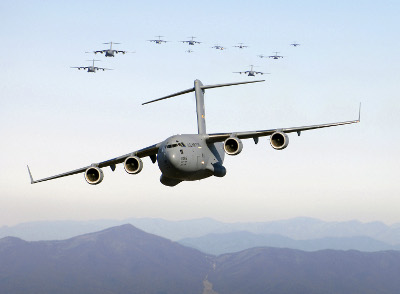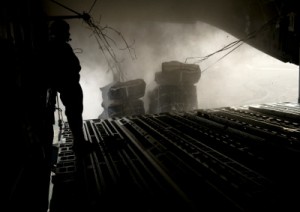Human Interest
121,000 pounds in 15 seconds

Their flight suits are soaked through with sweat, it’s 110 degrees outside and the smell in the C-17 Globemaster III resembles a high school locker room—we’re 30 minutes into our 15-hour mission.
Like most people who like to browse news on the war, I’ve seen many pictures and videos of supplies and cargo being dropped from an aircraft … the pallets of supplies float gracefully down and that is that. Never do I see the blood, sweat and tears that go behind getting those pallets to where they need to be.
C-17 pre-flight
The crew is alerted around 9 a.m. and arrives to the squadron 40 minutes later. They assemble for a highly detailed pre-mission brief that prepares the men for what they will face during their mission.
Once processed through customs, it’s time to arm up and head to the plane. Today is my first combat airdrop mission; our location is undisclosed in Southwest Asia. The air is heavy with humidity—you can actually feel the air on your skin. At this point, all we’ve done is place our bags on the C-17 and already our flight suits are drenched in sweat. Drops of perspiration are falling off the loadmaster’s face. We have 13 hours left in the day.
Even in the cargo bay of the massive C-17, room is at a premium. More than 73,000 pounds of JP8 fuel loaded on 40 pallets fill the aircraft from tail to nose, leaving just enough space for us to walk along the sides. The loadmaster’s voice comes over the speakers “ready for takeoff.” Within seconds our warehouse with wings is in the air.
Estimated time over target is two hours. The lights dim and things begin to cool off as we ascend.
Ready to drop

Staff Sgt. Stephen Adams, 816th Expeditionary Airlift Squadron loadmaster, observes 36,500 pounds of JP8 fuel fly out the back of a C-17 Globemaster III over Afghanistan July 8, 2011.
As we get closer to the drop zone, Staff Sgt. Russ Johnson, 816th Expeditionary Airlift Squadron loadmaster, signals a 30-minute warning. My two partners are no strangers to documenting airdrops, but for me, this is a new experience.
I strap myself into a seat in the back by the door. The aircraft dives, dips and dodges its way through the mountains of Afghanistan—I eye up the closest pile of puke-bags in case things go south for this guy.
The door opens at about 1,000 feet above the ground. I knew Afghanistan was mountainous, but I couldn’t have been prepared for what I saw. The mountains are high and the aircraft is low. It feels as though I could reach out and touch the mountaintops—I wasn’t too far off.
It’s game time. Red light … yellow light … green light. Within two seconds, 36,500 pounds of JP8 fuel violently races past me and out the aircraft, floating down to coalition troops on the ground. Our second pass drops another load.
Next load—and an attack
[ezadsense midpost]
Gearing up for our third drop, a stop is made at Bagram Airfield to refuel and load up another 48,000 pounds of Meals, Ready to Eat. As we’re parked on the ramp, the doors open and the tail goes down. For anyone who hasn’t been to BAF, it’s a sight to see. A bowl of mountains surround the airfield. On the ramp of the aircraft lay two loadmasters enjoying the sunset on what appears to be a peaceful evening.
With one pallet left to load on the plane, sirens go off. The peaceful moment disappears as the crew loading the plane runs for cover because, make no mistake about it, we are at war.
The news team and aircrew shelter in place on the aircraft. The sirens disappear and a new noise is heard. A pair of fighter jets and helicopters take to the sky. We all agree, someone is about to have a bad day.
More than an hour passes before the last pallet is finally loaded.
The sun is down and the sky is dark. Red lights illuminate the cargo area of the plane.
In preparation for the last drop of the mission, the lights dim. Looking through the viewfinder of my camera is a daunting task as visibility is close to nonexistent. We’re effectively an invisible flying Wal-Mart under the night sky. In a matter of 10 seconds, the doors open, the MREs blast out the door and we are on our way home.
Fifteen hours for about 15 seconds of actual action. Action that will keep my brothers and sisters fed, and their vehicles working.
The men and women of the 816th Expeditionary Airlift Squadron from Joint Base Charleston are game changers. They allow coalition forces to sustain operations in some of the most austere locations on Earth. They are force multipliers.
This article first appeared in Air Force Central on July 10, 2011.
Featured image: the C-17 Globemaster III in a low-level training mission over the Blue Ridge mountains of Virginia. Photo: United States Air Force.
[ezadsense leadout]



















